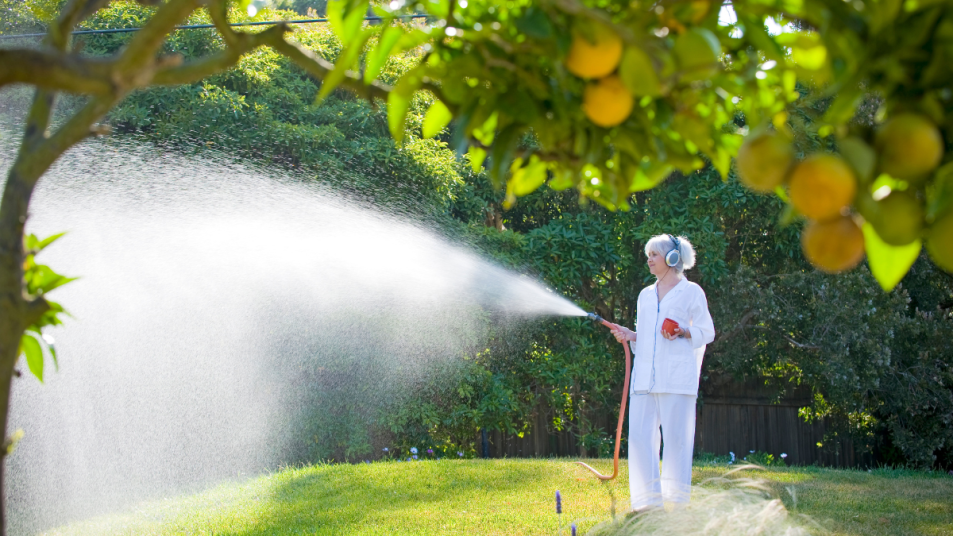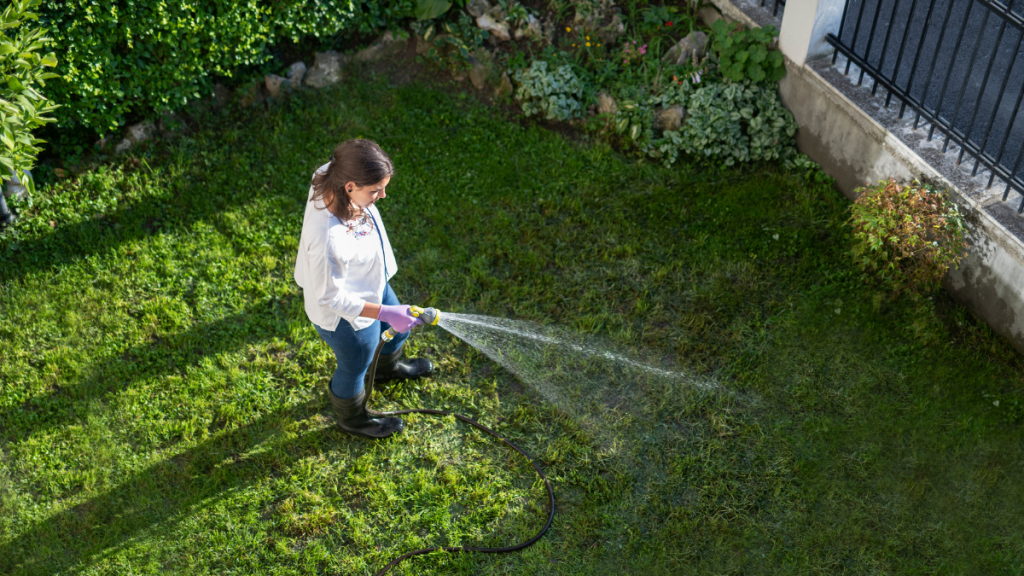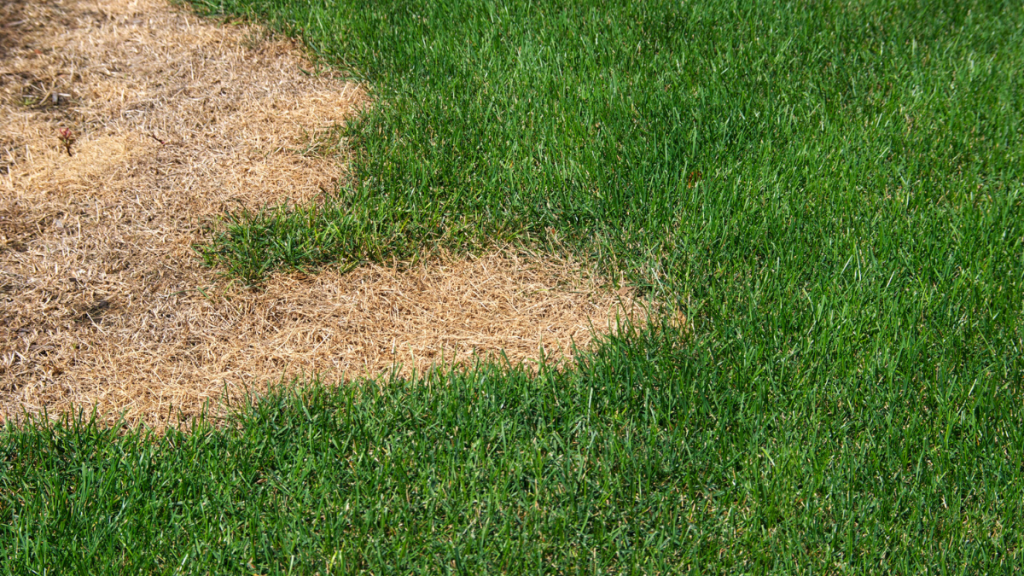The Best Time to Water Grass + The Simple Signs It Needs More
Plus the tuna can hack that tells you if you've watered enough

When you take pride in your lawn, the last thing you want to see is your once green and lush grass turn dry or brown. One of the most important parts of lawn care and maintenance is properly watering your grass. Of course, you can water your grass any time you’re able to do so, but an easy timing tweak is a simple way to help it truly thrive. And — surprise — it can even save you money! Read on for the expert advice on the best time to water grass, the ideal frequency of watering and the signs your lawn gives that you might need to adjust your strategy to keep it healthy and green.
What is the best time to water grass?
Earlier is better regarding the best time to water grass. Experts say watering a bit before sunrise is ideal. This way, you give the water as much time as possible to soak into the soil, reach the roots and be absorbed by the grass without losing too much of it to evaporation after the sun rises and its rays intensify.
The sun is necessary, though, for drying the grass blades and reducing the risk of bacteria and fungi growth, which is why you should try not to water your grass in the nighttime. Watering at this time also helps you waste less water and decrease that hefty water bill.
“Start your day right with a morning watering routine! Set your sprinklers between 4 a.m. and 10 a.m. for optimal results,” says Chandler Moncada of Creative Green Landscaping. “This time frame ensures cooler temperatures, calmer winds and minimal water loss to evaporation.”
How much and how often should you water grass?
In addition to knowing the best time to water grass, it’s important to take note of how much water to give your lawn. Experts say a total of 1 to 1.5 inches of water per week including both manual watering and rainfall is a good rule of thumb.
“It’s better to water deeply and less frequently than to water a little bit every day,” says Kenny Kwiatkowski, founder and CEO of the Grasshole lawn care system. “Typically, watering deeply two to three times a week is sufficient, but this depends on your soil type and climate.”
Taylor Olberding, co-owner of Heroes Lawn Care explains that clay soils hold moisture longer — sometimes even too long, depending on the composition. Sandy soils, on the other hand, don’t hold water as long and might need more frequent watering in droughts.

But, how can you tell when your grass has received the appropriate amount of water? To measure how much water your lawn has received — whether that be from the rain or your hose or sprinkler — experts suggest this smart hack: place empty tuna cans or a similar shallow container on your lawn before you start watering. Once you fill a tuna can, you’re looking at about an inch of water.
When it comes to frequency, it’s a common misconception that a lush, green lawn is achieved by watering the grass a little bit each day when, in fact, watering less frequently but more deeply encourages deep root growth and helps the lawn access water from deeper soil layers, making it less susceptible to drought.
Gene Caballero, landscaping expert and co-founder of GreenPal, adds that the few times each week that you water the grass might take about 20 to 30 minutes each, as this should ensure that the water reaches the roots deeply, promoting a strong, deep root system and a robust and healthy lawn.
How to know if you’ve over- or under-watered the grass?
While these tips are helpful, the amount of water your grass needs really depends on your specific climate and soil type, so how can you tell for certain whether you’re giving your grass what it needs? Lawn experts say you can tell you’re over-watering your grass when the soil is soggy, the ground feels spongy, there is water runoff, mushrooms begin to pop up or the grass is thinning.
“The consequences of over-watering include a shallow root system, potential fungal issues and a lawn more vulnerable to pests and diseases,” says Caballero. Olberding adds that over-watering can lead to unwanted weeds, and Kwiatkowski says that over-watering poses the risk of thatch build-up and root rot.
Under-watering causes the grass to become brittle and dry and wilt, and lead to brown and dead patches. Signs that the grass needs more water include a blue-gray tint, lingering footprints, discolored or dry-feeling grass.

The best method to water grass: sprinkler or hose?
While many lawn pros recommend underground irrigation systems, they can be pricey. Taking the manual route and using a hose or an affordable above-ground sprinkler system can be efficient as well.
“Hand watering with a hose allows for more targeted watering, which is great for newly seeded areas or patches of the lawn that are struggling,” explains Kwiatkowski. “However, it can be time-consuming and less consistent compared to sprinklers. Sprinkler systems, whether stationary, oscillating or rotary, offer more uniform water distribution and can be set on timers for convenience and efficiency. The key with sprinklers is to ensure they’re properly positioned to avoid wastage and to water the lawn, not the pavement. For the best results, consider your lawn’s specific needs and your own schedule to choose the method that works best for you.”
In this video by The Lawn Care Nut, lawn care expert Allyn Hane recommends an impact sprinkler for most lawns that don’t have in-ground irrigation systems. These sprinklers move the water quickly and efficiently, he says, but the exact setup of a manual system will vary and depend on water pressure in your location as well as the amount of grass you’re trying to cover.
Hane recommends first placing the sprinkler in different logical spots around the lawn to see where you can get the widest amount of coverage before adjusting the sprinkler’s position and track as necessary to move the stream up or down. He also uses tuna cans, placing them throughout the sprinkler’s stream and checking to see which spots need more water and when they’ve received the full inch.
“Soaker hoses are a fantastic option for efficient and cost-effective watering,” says Moncada. “They release water directly into the soil at a slow rate, minimizing water wastage due to evaporation or runoff. Place them strategically along your lawn, ensuring coverage without overlapping too much.”
Moncada also suggests opting for adjustable sprinklers that allow you to customize the watering pattern and coverage area to target specific areas of your lawn without unnecessary watering of sidewalks or driveways.
Check out these similar stories for more lawn and garden care tips:
5 Widely-Believed Gardening Myths You Should Start Ignoring
These 5 Kitchen Scraps Make Lawns and Gardens Greener, Say Experts (and Save Money on Fertilizers)
3 Genius Gardening Hacks for Maintaining the Most Beautiful Yard This Spring
















